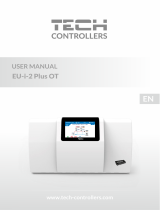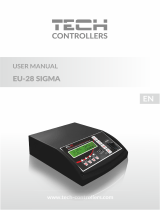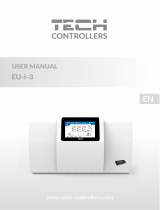4
II. DESCRIPTION OF THE DEVICE
DHW circulation regulator is intended for controlling DHW circulation to suit individual user's needs. In an economical
and convenient way, it reduces the time needed for hot water to reach the fixtures. It controls the circulating pump which,
when the user draws water, accelerates the flow of hot water to the fixture, exchanging the water there for hot water at
the desired temperature in the circulation branch and at the tap.
The system monitors the temperature set by the user in the circulation branch and it activates the pump only when the
pre-set temperature is lowered. Thus it does not generate any heat loss in the DHW system. It saves energy, water and
equipment in the system (eg circulation pump).
The circulation system operation is activated again only when hot water is needed and at the same time the pre-set
temperature in the circulation branch drops.
The device regulator offers all the functions necessary to adjust to various DHW circulation systems. It may control hot
water circulation or enable the circulating pump in case of heat source overheating (e.g. in solar heating systems). The
device offers pump anti-stop function (protecting against rotor lock) and adjustable working time of circulation pump
(defined by the user).
Additional functionalities:
- possibility of activating the pump e.g. for heat treatment of the system / anti-legionella function
- multilingual menu
- compatible with other devices e.g. DHW tank (DHW exchanger), continuous-flow water heater
The device is an intelligent, ecological solution for all hot water circulation circuits or other systems that perform similar
functions.
III. HOW TO INSTALL WATER FLOW SENSOR
The water flow sensor should be mounted on the cold water supply of the appliance (e.g. water tank) whose circulation
of hot water will be operated by the controller. Upstream of the sensor, it is necessary to mount a shut-off valve, a filter
preventing against contamination and possible damage of the device, as well as a check valve. The device may be
positioned vertically, horizontally or diagonally. Prior to mounting it on the piping system, remove the electronic sensor
by undoing 2xM4 screws from the sensor body. Once mounted on the piping system, the sensor should be screwed onto
the body.
The body of the flow sensor is equipped with 2 conical external threads ¾ that should be sealed in some way, ensuring
tight connection.
Use tools which do not damage the mechanical brass body of the device. Mount the body in accordance with the water
flow direction and the markings, and then connect the sensor wires to the control circuit following the connection
diagram.
The sensor should be mounted in a way which protects the electronical parts from dampness and eliminates any
mechanical stress in the system.























